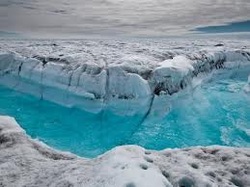
Modern regional atmospheric models and satellite observations have independently affirmed that the Greenland ice sheet is experiencing mass loss at a faster rate, according to a new study.
The mass loss is evenly spread out between increased production of iceberg, driven by the acceleration of fast-flowing outlet glaciers in Greenland, and increased production of meltwater at the surface of the ice sheet. Mass loss is further accelerated by warm summers to 273 Gt a year in 2006–2008, representing 0.75mm of global sea level rise every year.
”It is clear from these results that mass loss from Greenland has been accelerating since the late 1990s and the underlying causes suggest this trend is likely to continue in the near future. We have produced agreement between two totally independent estimates, giving us a lot of confidence in the numbers and our inferences about the processes,” said Jonathan Bamber, a professor at the University of Bristol, and author of the paper.
The Greenland ice sheet has sufficient amounts of water to produce a seven metre global sea level rise. Since 2000, it has lost a total of approximately 1500 Gt, indicating a global sea level rise of approximately half a millimetre every year on average.
While the surface melting rate increased around 1996, snowfall on the Greenland ice sheet also increased at about the same speed, covering surface mass losses for almost a decade.
The mass loss is evenly spread out between increased production of iceberg, driven by the acceleration of fast-flowing outlet glaciers in Greenland, and increased production of meltwater at the surface of the ice sheet. Mass loss is further accelerated by warm summers to 273 Gt a year in 2006–2008, representing 0.75mm of global sea level rise every year.
”It is clear from these results that mass loss from Greenland has been accelerating since the late 1990s and the underlying causes suggest this trend is likely to continue in the near future. We have produced agreement between two totally independent estimates, giving us a lot of confidence in the numbers and our inferences about the processes,” said Jonathan Bamber, a professor at the University of Bristol, and author of the paper.
The Greenland ice sheet has sufficient amounts of water to produce a seven metre global sea level rise. Since 2000, it has lost a total of approximately 1500 Gt, indicating a global sea level rise of approximately half a millimetre every year on average.
While the surface melting rate increased around 1996, snowfall on the Greenland ice sheet also increased at about the same speed, covering surface mass losses for almost a decade.
 RSS Feed
RSS Feed